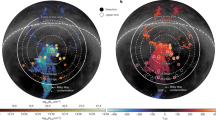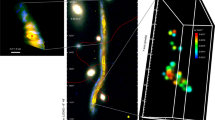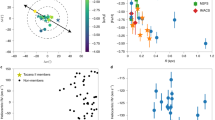Abstract
Few intergalactic, plausibly primordial clouds of neutral atomic hydrogen (H i) have been found in the local Universe, suggesting that such structures have either dispersed, become ionized or produced a stellar population on gigayear timescales. The Leo ring1,2, a massive (MH i ≈ 1.8 × 109 ,
,  denoting the solar mass), 200-kpc-wide structure orbiting the galaxies M105 and NGC 3384 with a 4-Gyr period, is a candidate primordial cloud. Despite repeated atttempts3,4, it has previously been seen only from H i emission, suggesting the absence of a stellar population. Here we report the detection of ultraviolet light from gaseous substructures of the Leo ring, which we attribute to recent massive star formation. The ultraviolet colour of the detected complexes is blue, implying the onset of a burst of star formation or continuous star formation of moderate (∼108-yr) duration. Measured ultraviolet–visible photometry favours models with low metallicity (Z ≈
denoting the solar mass), 200-kpc-wide structure orbiting the galaxies M105 and NGC 3384 with a 4-Gyr period, is a candidate primordial cloud. Despite repeated atttempts3,4, it has previously been seen only from H i emission, suggesting the absence of a stellar population. Here we report the detection of ultraviolet light from gaseous substructures of the Leo ring, which we attribute to recent massive star formation. The ultraviolet colour of the detected complexes is blue, implying the onset of a burst of star formation or continuous star formation of moderate (∼108-yr) duration. Measured ultraviolet–visible photometry favours models with low metallicity (Z ≈  /50–
/50– /5,
/5,  denoting the solar metallicity), that is, a low proportion of elements heavier than helium, although spectroscopic confirmation is needed. We speculate that the complexes are dwarf galaxies observed during their formation, but distinguished by their lack of a dark matter component5. In this regard, they resemble tidal dwarf galaxies, although without the enrichment preceding tidal stripping. If structures like the Leo ring were common in the early Universe, they may have produced a large, yet undetected, population of faint, metal-poor, halo-lacking dwarf galaxies.
denoting the solar metallicity), that is, a low proportion of elements heavier than helium, although spectroscopic confirmation is needed. We speculate that the complexes are dwarf galaxies observed during their formation, but distinguished by their lack of a dark matter component5. In this regard, they resemble tidal dwarf galaxies, although without the enrichment preceding tidal stripping. If structures like the Leo ring were common in the early Universe, they may have produced a large, yet undetected, population of faint, metal-poor, halo-lacking dwarf galaxies.
This is a preview of subscription content, access via your institution
Access options
Subscribe to this journal
Receive 51 print issues and online access
$199.00 per year
only $3.90 per issue
Buy this article
- Purchase on Springer Link
- Instant access to full article PDF
Prices may be subject to local taxes which are calculated during checkout




Similar content being viewed by others
References
Schneider, S. E., Helou, G., Salpeter, E. E. & Terzian, Y. Discovery of a large intergalactic HI cloud in the M96 group. Astrophys. J. 273, L1–L15 (1983)
Schneider, S. E. et al. Multifrequency survey of the intergalactic cloud in the M96 group. Astron. J. 97, 666–673 (1989)
Pierce, M. J. & Tully, R. B. The extragalactic HI cloud in Leo. Astron. J. 90, 450–453 (1985)
Kibblewhite, E. J., Cawson, M. G. M., Disney, M. J. & Phillips, S. An optical search for the intergalactic HI cloud in Leo. Mon. Not. R. Astron. Soc. 213, 111–115 (1985)
Schneider, S. E., Salpeter, E. E. & Terzian, Y. High-resolution observations of the intergalactic HI cloud in the M96 group. Astron. J. 91, 13–22 (1986)
Sil’chenko, O. K., Moiseev, A. V., Afanasiev, V. L., Chavushyan, V. H. & Valdes, J. R. The Leo I cloud: Secular nuclear evolution of NGC 3379, NGC 3384, and NGC3368? Astrophys. J. 591, 185–203 (2003)
Rood, H. J. & Williams, B. A. The intergalactic HI cloud in Leo – a simple modelling of the Spitzer-Baade collision event. Astrophys. J. 288, 535–550 (1985)
Spitzer, L. & Baade, W. Stellar populations and collisions of galaxies. Astrophys. J. 113, 413–418 (1951)
Bekki, K., Koribalski, B. S., Ryder, S. D. & Couch, W. J. Massive HI clouds with no optical counterparts as high-density regions of intragroup HI rings and arcs. Mon. Not. R. Astron. Soc. 357, L21–L25 (2005)
Schneider, S. E. Neutral hydrogen in the M96 group – the galaxies and the intergalactic ring. Astrophys. J. 343, 94–106 (1989)
Reynolds, R. J., Magee, K., Roesler, F. L., Scherb, F. & Harlander, J. H-alpha scans of the intergalactic HI cloud in Leo. Astrophys. J. 309, L9–L12 (1986)
Donahue, M., Aldering, G. & Stocke, J. T. Low surface brightness H-alpha observations of local intergalactic hydrogen clouds. Astrophys. J. 450, L45–L49 (1995)
Martin, D. C. et al. The Galaxy Evolution Explorer: a space ultraviolet survey mission. Astrophys. J. 619, L1–L6 (2005)
Bruzual, G. & Charlot, S. Stellar population synthesis at the resolution of 2003. Mon. Not. R. Astron. Soc. 344, 1000–1028 (2003)
Gil de Paz, A. et al. Chemical and photometric evolution of extended ultraviolet disks: optical spectroscopy of M83 (NGC 5236) and NGC 4625. Astrophys. J. 661, 115–134 (2007)
Meurer, G. et al. Evidence for a non-uniform initial mass function in the local Universe. Astrophys. J. (in the press)
Thilker, D. A. et al. A search for extended ultraviolet disk (XUV-disk) galaxies in the local universe. Astrophys. J. Suppl. Ser. 173, 538–571 (2007)
Boissier, S. et al. Radial variation of attenuation and star formation in the largest late-type disks observed with GALEX. Astrophys. J. Suppl. Ser. 173, 524–537 (2007)
Mihos, J. C., Harding, P., Feldmeier, J. & Morrison, H. Diffuse light in the Virgo Cluster. Astrophys. J. 631, L41–L44 (2005)
Aloisi, A. et al. I Zw 18 revisited with HST ACS and Cepheids: new distance and age. Astrophys. J. 667, L151–L154 (2007)
Ryan-Weber, E. V. et al. The local group dwarf Leo T: HI on the brink of star formation. Mon. Not. R. Astron. Soc. 384, 535–540 (2008)
de Jong, J. T. A. et al. The structural properties and star formation history of Leo T from deep LBT photometry. Astrophys. J. 680, 1112–1119 (2008)
Bournaud, F. & Duc, P.-A. From tidal dwarf galaxies to satellite galaxies. Astron. Astrophys. 456, 481–492 (2006)
Schneider, S. Neutral hydrogen in the M96 group – evidence for a giant intergalactic ring. Astrophys. J. 288, L33–L35 (1985)
Millis, R. L. et al. The Deep Ecliptic Survey: a search for Kuiper Belt Objects and Centaurs. I. Description of methods and initial results. Astron. J. 123, 2083–2109 (2002)
Adelman-McCarthy, J. K. et al. The sixth data release of the Sloan Digital Sky Survey. Astrophys. J. Suppl. Ser. 175, 297–313 (2008)
Schlegel, D. J., Finkbeiner, D. P. & Davis, M. Maps of dust infrared emission for use in estimation of reddening and cosmic microwave background radiation foregrounds. Astrophys. J. 500, 525–553 (1998)
Cardelli, J. A., Clayton, G. C. & Mathis, J. S. The relationship between infrared, optical, and ultraviolet extinction. Astrophys. J. 345, 245–256 (1989)
O’Donnell, J. E. R ν-dependent optical and near-ultraviolet extinction. Astrophys. J. 422, 158–163 (1994)
Acknowledgements
GALEX is a NASA Small Explorer, launched in April 2003. We gratefully acknowledge NASA’s support of the construction, operation, and science analysis for the GALEX mission, developed in cooperation with the Centre National d’Etudes Spatiales, France, and the Korean Ministry of Science and Technology. This research draws upon data provided by B. Millis as distributed by the National Optical Astronomy Observatory (NOAO) Science Archive. NOAO is operated by the Association of Universities for Research in Astronomy under a cooperative agreement with the National Science Foundation. This research has made use of the NASA/IPAC Extragalactic Database, which is operated by the Jet Propulsion Laboratory, California Institute of Technology, under contract with NASA. This research made use of NASA’s Astrophysics Data System.
Author information
Authors and Affiliations
Corresponding author
Rights and permissions
About this article
Cite this article
Thilker, D., Donovan, J., Schiminovich, D. et al. Massive star formation within the Leo ‘primordial’ ring. Nature 457, 990–993 (2009). https://doi.org/10.1038/nature07780
Received:
Accepted:
Issue Date:
DOI: https://doi.org/10.1038/nature07780
This article is cited by
-
GALEX and star formation
Astrophysics and Space Science (2011)
Comments
By submitting a comment you agree to abide by our Terms and Community Guidelines. If you find something abusive or that does not comply with our terms or guidelines please flag it as inappropriate.



